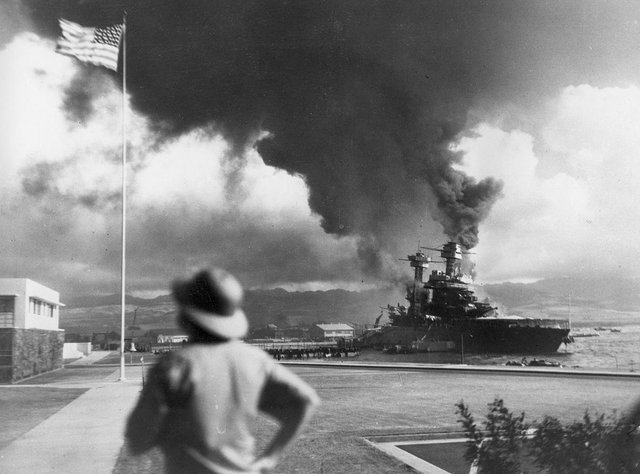1941 - Japanese attack on Pearl Harbor

On the morning of 7 December 1941, at 7.55am local time, 183 aircraft of the Imperial Japanese Navy attacked the United States Naval base at Pearl Harbor on the island of Oahu, Hawaii. Their intention was to destroy and damage as much of the US Pacific Fleet as possible, before it could respond to Japanese operations taking place on the same day against British, Dutch and US territories in southeast Asia.
This first attack wave began bombing the hangars and parked aircraft of the island’s airfields while at the same time launching torpedoes against the US warships moored in the harbour. In the first five minutes of the attack, four battleships were hit, including the USS Oklahoma and the USS Arizona. Minutes later, the Arizona exploded after a bomb hit its gunpowder stores, sinking the ship and killing 1,177 of its crew.
This devastating attack was followed an hour and a half later by a second wave of 170 Japanese aircraft. Within two hours, 18 US warships had been sunk or damaged, 188 aircraft destroyed and 2,403 American servicemen and women killed. Many of these ships were repaired and fought in later battles, and, crucially all three of the Pacific Fleet’s aircraft carriers were not at Pearl Harbor during the attack and so escaped damage. They were to prove vital in the coming Pacific Campaign.
Although the attack was a complete surprise, many American servicemen were able to fight back. Some US airmen were even able to get their aircraft into the sky while their runways were under attack. 2nd Lieutenants Kenneth M. Taylor and George Welch had been sleeping after a late-night Christmas party when they heard the sounds of explosions and machine gun fire. Still wearing their tuxedoes from the night before, they raced to their waiting aircraft. Together they shot down seven Japanese aircraft and were both awarded the Distinguished Service Cross, the second highest award for gallantry in the US Army Air Corps at the time.
Before the attack on Pearl Harbor the United States had been supporting Allied forces with weapons and supplies, under the Lend-Lease Agreement, but many in the country were reluctant to enter the war. The day after the attack, President Franklin D. Roosevelt delivered a speech to the United States Congress urging for a formal declaration of war against Japan. War was declared an hour later, bringing the United States into the Second World War and unifying the country behind the war effort.
TO LEARN MORE ABOUT HISTORICAL EVENTS IN the 1940s VISIT History0x